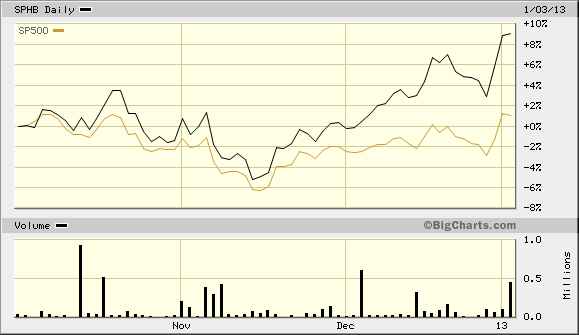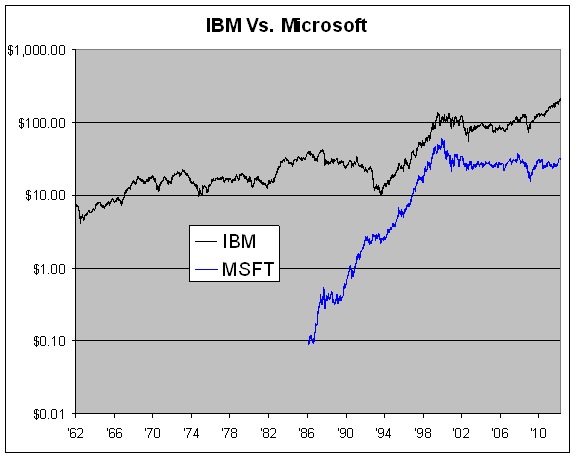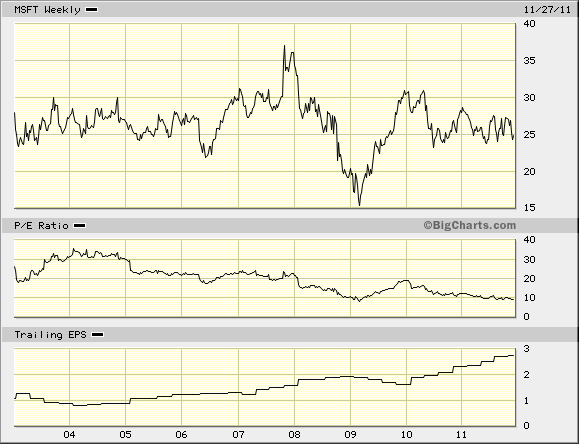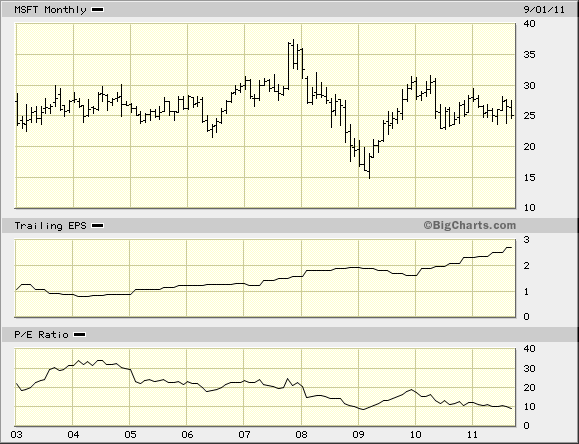Posts Tagged ‘msft’
-
CWS Market Review – January 4, 2013
Eddy Elfenbein, January 4th, 2013 at 8:17 am“You get recessions, you have stock market declines. If you don’t understand
that’s going to happen, then you’re not ready, you won’t do well in the markets.”
– Peter LynchHappy New Year! This has been an exciting week: the Fiscal Cliff is done and gone, stocks are near multi-year highs and our Buy List officially beat the market for the sixth year in a row!
For the last several weeks, I’ve been telling investors not to get caught up in all the ridiculous hype surrounding the Fiscal Cliff. What else can I say but that the financial media behaved irresponsibly in stoking the fears of this manufactured crisis? Congress was even worse. At some point, I believed, a deal would be reached—and that’s exactly what happened.
The market celebrated the deal on Wednesday with its strongest rally in more than a year. In just two days, the Volatility Index ($VIX), also known as the Fear Index, plunged by one-third, and the S&P 500 made back everything it had lost since mid-October. Before a late-day sell-off on Thursday, the index was flirting with its highest close since 2007. On top of that, our 2013 Buy List has already grabbed a slight lead over the S&P 500.
It’s times like this I’m glad we’re long-term investors. I can’t imagine what it’s like trading through all these vacuous pronouncements during the Fiscal Cliff debate. The math is still very much on the side of stocks. Six weeks ago, I told you I thought the S&P 500 would break 1,500 sometime early this year. At the time, that seemed like a bold forecast. Now it looks more like a cakewalk. The index is currently less than 3% away from topping 1,500.
In this week’s CWS Market Review, we’ll take a look at what’s driving the current rally. Plus, Q4 earnings season is only days away and I’m expecting solid results from our Buy List stocks. In fact, one of the newbies on our Buy List is already making waves. Ross Stores ($ROST) soared 8% on Thursday on higher earnings guidance! This came exactly one day after an analyst at Citigroup downgraded Ross. Now let’s take a look at the current market.
The High-Beta Rally
The big two-day surge we just had was interesting because it comprised the final trading day of one year and the opening day of the next. This past December 31st was the single-best final-day gain since 1974.
But this hasn’t been a standard rally. It’s been what traders call a “high-beta” rally. These are rallies that have concentrated on the most volatile stocks (or more technically, it’s correlated volatility). That’s why we’ve seen small-cap stocks and tech stocks do the best. The Russell 2000 ($RUT), which is a widely-followed index of small-cap stocks, just broke out to a new all-time high. The Equal Weighted version of the S&P 500 also hit an all-time high. The regular S&P 500 is weighted by market cap, so the mega-caps, which have been lagging of late, have greater weight.
Here’s a chart showing a High-Beta ETF ($SPHB) compared with the S&P 500, and you can see that’s been crushing the market lately.
Cyclical stocks also tend to do well during high-beta rallies. In essence, what the market is doing is shifting towards riskier assets. This is good news because investors need to be rewarded for being willing to shoulder more risk. It’s the willingness to put your money down that helps the entire economy move along. The move has been slow, but the market is becoming more risk-friendly. High-yield spreads, for example, are at an 18-month low, and high-dividend stocks were laggards in 2012.
When the world economy went kablooey a couple of years ago, everyone ran screaming to the most secure assets. Gold and U.S. Treasuries soared as stocks and junk bonds plunged into the abyss. Banks and businesses just sat on their cash. But a major turning point came last summer when Mario Draghi made his now-famous statement: “Within our mandate, the ECB is ready to do whatever it takes to preserve the euro. And believe me, it will be enough.” My friends, that’s what we call a game-changer.
Even though this was an announcement from a European central banker, it sent shock waves around the world, and investors here in the U.S. took this as a signal to move towards risk. When I use the word “risk” here I don’t mean to use it with the negative connotations of recklessness or imprudence. Rather, I mean areas that have a longer time horizon to pay off. For example, I have a pretty good idea where Treasury bill yields will be in a week, but I have no idea what AFLAC’s ($AFL) stock will do. Yet over the next, say, two or three years, I have a very high level of confidence that AFLAC will still be pulling down a sizeable profit despite a fluctuating stock market. The latter investment simply needs more time to pay off.
I should also point out that it isn’t so much that investors are becoming riskier. Instead, it’s that investors are moving from a state of extreme risk-phobia to a more normal state of affairs. The day before Dragi’s statement, the yield on 10-year Treasury bonds hit an historic low of 1.4%. Since then, they’ve soared all the way to a still-puny 1.9%. Put it this way: Microsoft ($MSFT), which is a new member of the Buy List, is one of the largest and best-known blue chips stocks in the world, yet its yield is nearly double that of the 10-year.
The rotation towards risk got another big boost a few weeks after Draghi’s announcement when the Federal Reserve said it would pursue its QE Infinity policy. I should add that I was completely and totally wrong about this announcement. For weeks beforehand, I had said that the Fed was in no way pursing such a policy. Shows what I know!
Fortunately, our Buy List was perfectly poised to ride the market’s rotation. One great example is Ford Motor ($F). In the CWS Market Review from August 24th, I highlighted Ford as a good bargain. I wrote: “I don’t see how the stock can go for less than $10, but it is.” Just a few days before I wrote that, I remember that Ford had even dropped below $9. But patience once again paid off for us. Yesterday, shares of Ford got as high as $13.70. The stock is up more than 52% from its summer low.
The company just announced that December sales rose 1.9%. It was Ford’s best December since 2006. Look for another solid earnings report later this month. Ford remains an excellent buy up to $15 per share.
Ross Stores Soar 8% on Higher Guidance
One of the new stocks on this year’s Buy List is Ross Stores ($ROST). This is a very solid retailer. On Thursday, one day after an analyst at Citigroup downgraded the stock, ROST reported outstanding sales and guided higher for Q4. December sales rose 11% to $1.276 billion.
The key metric for a retailer is comparable-store sales. Wall Street was expecting ROST to report an increase of 2.7%. Instead, it was 6%. The company also raised its earnings guidance for Q4 (which ends in one month). Before, Ross was expecting earnings of 99 cents to $1.04 per share. Now they expect earnings of $1.04 to $1.05 per share. Ross expects comparable-store sales to rise between 1% and 2% for January. This is excellent news. The shares gapped up 7.97% on Thursday to close at $58.78. Thanks to the rally, I’m raising my Buy Below on Ross to $62 per share. Expect to see their 19th-straight annual dividend increase in a few weeks.
Before I go, I want to point out some good bargains on the Buy List. Bed Bath & Beyond ($BBBY) has dropped down recently. My Buy Below price is currently $60, but if you can get BBBY below $57, that’s a really good deal for the long-term. CA Technologies ($CA) is pretty cheap. At its price, CA yields 4.42%. Also, Microsoft ($MSFT) continues to be the stock everyone loves to hate, but it looks very attractive below $28 per share. Actually, one of the reasons why I like it is that everyone else hates it so much. MSFT currently yields 3.38%.
That’s all for now. Earnings season starts next week. Our first Buy List stock to report will be Wells Fargo ($WFC) on Friday, January 11th. Wall Street currently expects 90 cents per share, which sounds about right. Wells is a good buy up to $37. Be sure to keep checking the blog for daily updates. I’ll have more market analysis for you in the next issue of CWS Market Review!
– Eddy
P.S. It’s official. I’m very happy to report that our Buy List beat the S&P 500 for the sixth year in a row in 2012. The 20 stocks on the Crossing Wall Street Buy List gained 14.56%, while the S&P gained 13.41%. Including dividends, our Buy List gained 17.85%, compared with 16.00% for the S&P.
-
IBM Vs. Microsoft
Eddy Elfenbein, April 16th, 2012 at 11:17 amHere’s a look at IBM’s ($IBM) stock compared with Microsoft’s ($MSFT). This is a race that hasn’t gone the way many people would have thought.
If you had asked most experts on December 31, 1999, which is a better buy—IBM or Microsoft, I’m pretty sure the majority would have sided with Microsoft. Instead, IBM has won the contest hands down with an 88% gain compared with a 47% loss for Microsoft.
If we were to measure from Microsoft’s IPO in March 1986 until the end of the century, that’s a very different story. Microsoft would have won with a 600-fold gain to IBM’s triple. Over most of the last ten years, Microsoft’s stock has been flat. IBM has been an especially strong stock in the last three years.
The lesson here is that companies left for dead can turn themselves around, while companies that have seemingly won the race can quickly lose their edge.
-
Is Microsoft a Value Stock?
Eddy Elfenbein, November 30th, 2011 at 2:44 pmCheck out the plunge in Microsoft‘s ($MSFT) P/E Ratio:
Even though Microsoft’s earnings have risen steadily, the stock has basically ranged between $25 and $30 for the last eight years. Add the two phenomena together and you get a declining Price/Earnings Ratio.
So is the stock cheap? Maybe.
For the fiscal year ending in June 2012, Microsoft is expected to earn $2.75 per share. The stock is currently going for 9.24 times that.
Over those same four quarters, the S&P 500 is expected to earn $101.73. At the current price, the index is going for 11.17 times that. This means that Microsoft’s valuation is 17% less than the overall market’s.
Also, bear in mind that Microsoft recently raised its quarterly dividend to 20 cents per share. That 80-cent dividend for the year works out to a yield of 3.15%.
-
The Plunge in Microsoft’s Valuation
Eddy Elfenbein, September 26th, 2011 at 12:28 pmFor the last 16 months, shares of Microsoft ($MSFT) have mostly been locked in a tight trading range between $24 and $28 per share. The stock has crept out of that range only a few times.
What’s amazing is how far Microsoft’s valuation has fallen (see chart below). The stock dipped below $25 per share today. For the last fiscal year, the computer giant earned $2.69 per share, so that’s a trailing P/E Ratio of 9.3.
Analysts on Wall Street expect earnings for the current fiscal year, ending in June 2012, of $2.86 per share. For the year after that, analysts see earnings of $3.13 per share. So the company is still growing, albeit not like it was 15 years ago.
The chart below shows MSFT’s price over the last ten years along with its earnings-per-share and P/E Ratio. Notice how steeply the P/E Ratio has plunged.
Basically, MSFT has shifted from being a growth stock into being a value stock. It must sound odd to anyone who remembers the go-go days of the 1990s to call Microsoft a “value stock,” but look at the facts.
The company just raised its quarterly dividend by 25% to 20 cents per share. At $25 per share, an 80-cent annual dividend comes yields 3.2% which is more than a 30-year Treasury.
Bear in mind that Microsoft is rated Triple-A while U.S. government debt is not.
-
LinkedIn and the Winner-Take-All
Eddy Elfenbein, May 23rd, 2011 at 8:43 amWith the success of LindedIn’s ($LNKD) IPO, I want to discuss one of the reasons, in my opinion, why Internet stocks have caused such a frenzy for a little over a decade.
One of the popular ideas that swept thinking circles in the mid-1990s was the impact of what economists call “natural monopolies.” The idea was also known as “the first mover advantage.” Robert Frank’s book, “The Winner-Take-All Society,” also touched on these themes.
The general idea is that if a company is the first to unveil a certain type of product, it becomes “the standard.” This is crucial because it’s in everyone’s interest to recognize it as the standard.
Probably the best example is Microsoft’s ($MSFT) Windows. Once Windows was established as the standard, so the idea goes, no one could knock it off and the company enjoyed an enormous competitive advantage. There’s no need to for two operating systems. Similarly, there was no need for VHS and Betamax to exist. (In econo-speak, a natural monopoly has very high fixed costs relative to its variable costs.)
Likewise, when one company is established on the Internet, say selling pet supplies as advertised by a sock puppet, it will hold a near-monopoly over the entire industry. As a result, the normal metrics of valuing a company need not apply. Or so we were told.
I remember how often I was told that some Internet stock was going to be huge and that it all had to do with the QWERTY keyboard. This was the easy way to explain the first-mover advantage. The story is that the QWERTY keyboard was established in the 19th century even though it’s an inefficient layout. The reason it won out, and is still around today, is that it became enthroned as the standard. QWERTY became the winner, and it took all.
The takeaway is that the better mousetrap didn’t win the race (I’m mixing metaphors; deal). The worse keyboard board won only because it was first. Again, so we were told.
It’s hard to emphasize strongly enough how widespread these ideas were. In Bill Clinton’s re-election campaign, he often warned voters about the emergence of the winner-take-all society. In 1998, there was even a new tech magazine called The Industry Standard.
Today, LinkedIn potentially holds a similar winner-take-all grip over the resume market. Why bother being listed some place? The problem with the winner-take-all thesis is that it doesn’t always hold. Industry standards do get knocked out. It may take time, but it can happen.
By the way, not all the stories we told we true. In typing contests, for example, QWERTY has held its own as an efficient layout. The biggest threat to natural monopolies comes, not from a competitor, but from innovation. As a result, these standards can be far more vulnerable than we realize. That’s why I’m so suspicious of the elevated price for LinkedIn.
One more thing: in 2001, the The Industry Standard went bankrupt.
-
-
Archives
- April 2025
- March 2025
- February 2025
- January 2025
- December 2024
- November 2024
- October 2024
- September 2024
- August 2024
- July 2024
- June 2024
- May 2024
- April 2024
- March 2024
- February 2024
- January 2024
- December 2023
- November 2023
- October 2023
- September 2023
- August 2023
- July 2023
- June 2023
- May 2023
- April 2023
- March 2023
- February 2023
- January 2023
- December 2022
- November 2022
- October 2022
- September 2022
- August 2022
- July 2022
- June 2022
- May 2022
- April 2022
- March 2022
- February 2022
- January 2022
- December 2021
- November 2021
- October 2021
- September 2021
- August 2021
- July 2021
- June 2021
- May 2021
- April 2021
- March 2021
- February 2021
- January 2021
- December 2020
- November 2020
- October 2020
- September 2020
- August 2020
- July 2020
- June 2020
- May 2020
- April 2020
- March 2020
- February 2020
- January 2020
- December 2019
- November 2019
- October 2019
- September 2019
- August 2019
- July 2019
- June 2019
- May 2019
- April 2019
- March 2019
- February 2019
- January 2019
- December 2018
- November 2018
- October 2018
- September 2018
- August 2018
- July 2018
- June 2018
- May 2018
- April 2018
- March 2018
- February 2018
- January 2018
- December 2017
- November 2017
- October 2017
- September 2017
- August 2017
- July 2017
- June 2017
- May 2017
- April 2017
- March 2017
- February 2017
- January 2017
- December 2016
- November 2016
- October 2016
- September 2016
- August 2016
- July 2016
- June 2016
- May 2016
- April 2016
- March 2016
- February 2016
- January 2016
- December 2015
- November 2015
- October 2015
- September 2015
- August 2015
- July 2015
- June 2015
- May 2015
- April 2015
- March 2015
- February 2015
- January 2015
- December 2014
- November 2014
- October 2014
- September 2014
- August 2014
- July 2014
- June 2014
- May 2014
- April 2014
- March 2014
- February 2014
- January 2014
- December 2013
- November 2013
- October 2013
- September 2013
- August 2013
- July 2013
- June 2013
- May 2013
- April 2013
- March 2013
- February 2013
- January 2013
- December 2012
- November 2012
- October 2012
- September 2012
- August 2012
- July 2012
- June 2012
- May 2012
- April 2012
- March 2012
- February 2012
- January 2012
- December 2011
- November 2011
- October 2011
- September 2011
- August 2011
- July 2011
- June 2011
- May 2011
- April 2011
- March 2011
- February 2011
- January 2011
- December 2010
- November 2010
- October 2010
- September 2010
- August 2010
- July 2010
- June 2010
- May 2010
- April 2010
- March 2010
- February 2010
- January 2010
- December 2009
- November 2009
- October 2009
- September 2009
- August 2009
- July 2009
- June 2009
- May 2009
- April 2009
- March 2009
- February 2009
- January 2009
- December 2008
- November 2008
- October 2008
- September 2008
- August 2008
- July 2008
- June 2008
- May 2008
- April 2008
- March 2008
- February 2008
- January 2008
- December 2007
- November 2007
- October 2007
- September 2007
- August 2007
- July 2007
- June 2007
- May 2007
- April 2007
- March 2007
- February 2007
- January 2007
- December 2006
- November 2006
- October 2006
- September 2006
- August 2006
- July 2006
- June 2006
- May 2006
- April 2006
- March 2006
- February 2006
- January 2006
- December 2005
- November 2005
- October 2005
- September 2005
- August 2005
- July 2005




 Eddy Elfenbein is a Washington, DC-based speaker, portfolio manager and editor of the blog Crossing Wall Street. His
Eddy Elfenbein is a Washington, DC-based speaker, portfolio manager and editor of the blog Crossing Wall Street. His